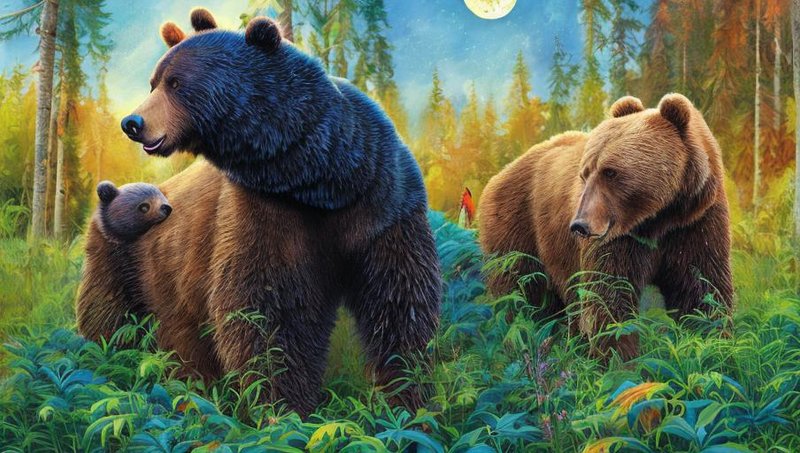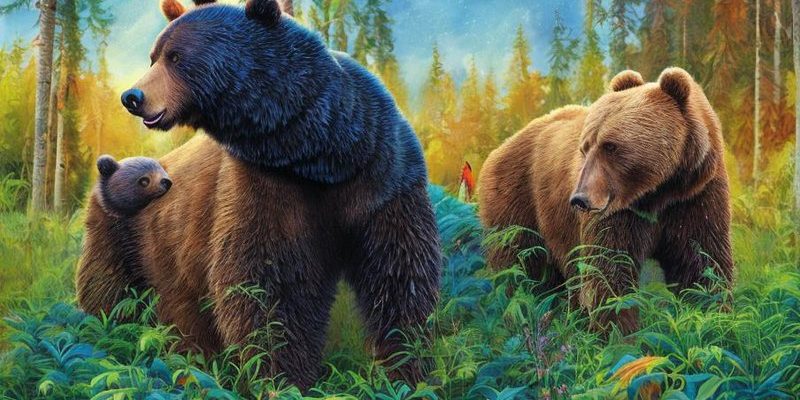
You might be surprised to know that these majestic creatures have a hand in everything from seed dispersal to nutrient cycling. They’re like nature’s gardeners and keepers, ensuring that various plants and animals can thrive. As we sip our coffee, let’s take a closer look at the multifaceted role bears play in maintaining ecological balance.
The Different Types of Bears
Bears belong to the family Ursidae, and there are eight species found worldwide. Each type of bear has its unique traits and habits. Here are the main types:
- American Black Bear: Found across North America, these bears are known for their versatility in diet and habitat.
- Grizzly Bear: A subspecies of the brown bear, they thrive in the forests and mountains of Alaska and western Canada.
- Panda Bear: Native to China, these bears primarily eat bamboo and are often seen as symbols of conservation.
- Polar Bear: Living in the Arctic, these bears are experts at hunting seals and navigating icy waters.
- Asiatic Black Bear: Also known as moon bears, they roam the forests of Asia and are recognizable by their distinct white chest markings.
Each bear species contributes differently to its ecosystem, depending on its diet, behavior, and habitat. For example, while polar bears are excellent hunters in the Arctic, American black bears play a role in forest ecosystems by managing their surroundings through foraging.
Seed Dispersal and Plant Growth
Bears are more than just big furry animals; they also act as important seed dispersers. When they eat fruits and berries, like blueberries and salmonberries, the seeds often pass through their digestive tract unharmed. This means that when they poop, they’re literally planting seeds all over the place!
Imagine a bear munching on delicious berries near a stream. As it roams the landscape, it leaves behind seeds that can sprout into new plants. This is crucial for the health of forest ecosystems. More plants mean more food and shelter for other animals. Without bears, many plant species would struggle to spread and thrive.
Let’s not forget about diversity, either! The variety of plants that sprout thanks to bear droppings helps build a more resilient ecosystem. When diverse plant life exists, it can support a wider range of animals, leading to a richer and more balanced environment.
Nutrient Cycling
The role of bears in nutrient cycling is another fascinating aspect of their ecosystem contribution. When bears fish for salmon in rivers and streams, they don’t eat all of it. Some fish remains are left behind, or the bears may catch more than they can consume. These leftover fish decay, releasing nutrients back into the soil and water.
This nutrient cycling is vital for the surrounding ecosystems. It enriches the soil, which supports plant life and ultimately benefits herbivores and carnivores. Think of it as bears being nature’s composters! The more nutrients available, the healthier the entire ecosystem becomes.
Furthermore, research shows that these nutrients can even travel far from the riverbanks where the bears fish, thanks to rain and runoff. You could say that bears help to nourish their entire habitat, even if they weren’t physically there!
Impact on Prey Populations
Bears also influence prey populations, which can have a ripple effect on the ecosystem. By hunting smaller animals, such as deer or rodents, they help maintain a balance in these populations. When bears are present, they tend to keep herbivore populations in check.
This balance is crucial because, if herbivore numbers grow too high, they can overgraze and damage plant communities. Imagine a field of wildflowers being devoured by hungry deer. Without bears to manage these deer populations, not only do the flowers suffer, but the animals that depend on those plants for survival also face challenges.
On the flip side, when bear populations decline, herbivores can surge, leading to overpopulation and habitat destruction. This cycle can have long-lasting impacts, showing just how significant bears are in regulating their ecosystems.
Competition and Cooperation with Other Species
Bears don’t exist in a vacuum; they interact with a plethora of other species in their habitats. They often compete with other large mammals for food resources. However, they can also engage in unique relationships, like scavenging leftovers from other predators.
For example, after a wolf pack has finished feeding on a deer, bears will often come in to take advantage of the remains. This dynamic can have a positive effect, as it ensures that food is not wasted and supports multiple species within the same ecosystem.
Moreover, the presence of bears can influence the behavior of other species, leading to a more complex web of interactions. Smaller animals, like smaller mammals or birds, may adjust their foraging patterns based on bear activity, ensuring they don’t become dinner themselves. This kind of indirect impact emphasizes how bears serve as a keystone species—meaning their presence is key to maintaining healthy ecosystems.
Conservation and Protection of Bears
Given their vital role in the ecosystem, it’s essential to ensure that bear populations are healthy and protected. Unfortunately, habitat loss, climate change, and hunting threaten many bear species. When bear populations decline, it can cause a cascade of negative effects throughout their habitat.
Conservation efforts focus on preserving their natural habitats, creating protected areas, and implementing laws to prevent poaching. Additionally, raising awareness about the importance of bears helps foster a greater appreciation for these magnificent creatures.
A healthy bear population is good for the environment and signifies a balanced ecosystem. It’s crucial for us to recognize that by protecting bears, we are ultimately safeguarding the health of our planet.
Final Thoughts on Bears and Ecosystem Health
Bears may seem like just big predators lumbering through their habitats, but their true influence on ecosystems is profound. From seed dispersal to nutrient cycling, managing prey populations to enriching the environment in collaboration with others, bears are essential players in maintaining ecological balance.
So, the next time you think about bears, take a moment to appreciate their role in the great symphony of nature. We all share this planet, and by understanding and respecting the importance of these creatures, we can contribute to a healthier environment for future generations. Let’s keep the bear’s role in its ecosystem front and center as we work towards conservation and sustainability.

